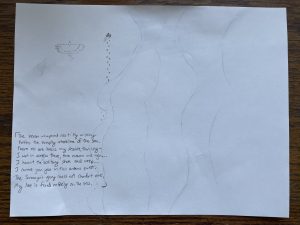conference of one

on conference of one:
conference of one is a pencil sketch inspired by the Heron in Farid Ud-din Attar’s canonical text The Conference of the Birds. I was moved by the descriptions of all of the birds, and their “excuses” for not searching for God. And while I saw myself in more than a few of the birds — the hermitage of the Owl, the vanity of the great Homa — I was moved most strongly by the Heron, who describes himself as too sad for the journey to God, and is resigned to his fate moping alone by the seashore.
I represented this through the minimalist sketch of a person wandering along the seashore, and a ghastly heron flying by their side. I chose to do the sketch in pencil because it best conveyed the bleakness and loneliness of such an existence without God, as Attar would likely argue. This choice also forces you to focus on the beautiful words of Attar, which are as follows:
The heron whimpered next: ‘My misery
Prefers the empty shoreline of the sea.
There no one hears my desolate, thin cry —
I wait in sorrow there, there mourn and sigh. . .
I haunt the solitary shore and weep . . .
I cannot join you in this arduous quest. . .
The Simorgh’s glory could not comfort me;
My love is fixed entirely on the sea.” (Attar, trans. Darbandi and Davis, 57)
I really tried to convey the loneliness that the Heron felt, and was quite empathetic to the bird in doing so, even though in The Conference of the Birds, the bird is proven to be wrong by the Hoopoe and goes on the journey to the Simorgh anyway. I chose this passage because on one level it really resonated with me — this gut feeling that perhaps it is all worth nothing, that your sadness is inconsolable, a desire to just get away from people and take a long, dramatic look at your world. But ultimately, as we see in The Conference of the Birds, this method will not bear any fruit. The Hoopoe bird asks the Heron about his attempts to find solace in the sea as such:
since she cannot rest,
What peace could you discover in her breast? (Attar, trans. Darbandi and Davis, 58).
Ultimately, with this work I hope to better understand the figure of the Heron, and represent its loneliness that is, although perhaps leading to distraction from God, all too real. The title of the work is an ironic twist, because conference of one may be interpreted as a way to describe tawhid, or the simultaneous unicity of God, but contextually it represents the loneliness of the Heron with a play off of the title of Attar’s work. In this subversive way, I try to honor the lived experience of those who are suffering, and lend an empathetic ear to those who may be doubtful of claims of divine salvation, even as they may be true.
note: reflection is from Week 10 Section readings